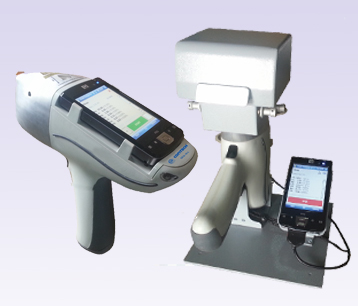GOLD PURITY CHECKING INSTRUMENTS
X-RAY FLUORESCENCE SPECTROMETER HANDHELD DETECTORS (Si-PIN / SDD) CGX-104
XRF is used to detect and analyze noble metals like Gold ( Au), Silver (Ag), Platinum (Pt),Iridium (Ir), Osmium (Os), Palladium (Pd), Rhodium (Rh), Ruthenium (Ru), Copper (Cu), Zinc (Zn), Nickel (Ni), Cadmium (Cd), Iron (Fe), Cobalt (Co), Indium (In), Tin (Sn), in the Jewellery Industry.
Energy Dispersive X-ray Fluorescence (EDXRF) technique relies on the detector and the detection circuit capability to resolve spectral peaks due to different energy X-Rays emitted when a primary X-Ray beam strikes a metal alloy corresponding to different elements in the sample, intensity of the spectrum radiation proportional to the concentration of element. The spectrum is then processed through the powerful computer software which calculates and reports the various elements & their composition in the sample.
XRF Gold Purity Tester consists of X-Ray tube, high voltage power supply for X-Ray source,X-Ray tube filters, X-Ray fluorescence Detector, processing electronics and system interface& an external computer. A camera is incorporated in the system to view the sample on the computer screen.
Specifications:
| X-ray tube | Tungsten anode, 40 kV , 100 µA with 5 filter positions |
| Detector type | solid state Si-pin-diode with thermo-electrical cooling (optional SDD) |
| Active area | 6 mm2 |
| Energy resolution | <165 eV at 5.9 keV (<140 eV for SDD) |
| Display | High resolution 4 inch color touch-screen |
| Supported operating systems |
Windows CE/Mobile for PDA Windows XP/Vista/7 for PC |
Battery Operation Time : Up to 8 hours
Dimensions : 242 mm (L) x 78 mm (W) x 230 mm (H)
Weight (with battery) : 1230 g (1440 g)
XRF is a reference technique, hence standards are required for quantitative results. Standards are analyzed, spectral intensities generated are used to obtain a intensity v/s concentration plot for calibration. This calibration is used to evaluate the spectral intensities of unknown samples.
How to get best results from XRF Spectrometer :
XRF is a reference method, proper standardization of the equipment is required for accurate results.
In order to get most appropriate results, testing at different points is necessary especially when the jewellery design is intricate.
Adequate warm up period, sturdy working surface, stable power supply, proper grounding and conditioned atmosphere is required to achieve the best product performance.
For powder sample, proper grinding of sample minimizes scattering effect.
For solid sample, surface polishing minimizes the scattering effect.
Flat surface of the sample yields the best results.
Due to different melting points, atomic structure and crafting techniques, not all the elements can be melted with noble metals.




